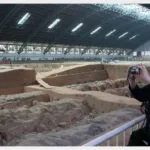Nestled in the serene Western Hills of Beijing, Dajue Temple is a thousand-year-old sanctuary where nature and history intertwine. Known among locals for its poetic nickname, “The Ancient Temple of Fragrant Magnolias,” this peaceful site offers far more than just religious significance.
This guide will take you deep into the world of Beijing Dajue Temple. We’ll explore its rich history, distinctive architecture, seasonal beauty, cultural events, and everything you need to plan your visit — from how to get there, to when to go, to what not to miss. You’ll also discover hidden gems like its tranquil Zen tea experience, nestled quietly behind red walls and gray tiles.
1. History and Overview of Dajue Temple
The temple was first built in 1068, during the Liao Dynasty, under the name Qingshuiyuan (Clear Water Courtyard). In the Jin Dynasty, it became one of the renowned Eight Water Temples of the Western Hills. Over the centuries, Dajue Temple has witnessed the rise and fall of five dynasties — Liao, Jin, Yuan, Ming, and Qing — with each era leaving its mark through expansions and restorations. What remains today is a harmonious blend of ancient architecture and spiritual legacy.
Covering an area of about 9,500 square meters, the temple is laid out in a classic mountain-temple style — built into the slope, facing east, with the majestic Western Hills as its backdrop.
The layout is divided into three main sections:
- The Central Axis: This is the heart of religious activity, home to key structures such as the Mountain Gate, Stele Pavilion, Merit Pool, Bell and Drum Towers, Hall of Heavenly Kings, and the Mahavira Hall — the spiritual centerpiece of the complex.
- The Southern Wing: Originally used as a royal retreat, this area was where Qing dynasty imperial family members rested during their visits for prayer and reflection.
- The Northern Wing: This quieter area once housed the monastic quarters, where monks lived and practiced.
This carefully planned layout — with a central temple core, southern palace, and northern living quarters — reflects Dajue Temple’s status as a royally patronized monastery and showcases the elegance and order of traditional Chinese religious architecture.
2. Core Architectural Highlights of Dajue Temple
Beijing Dajue Temple’s central axis preserves an ancient Liao dynasty tradition — buildings face east to greet the rising sun. This layout reflects a deep-rooted reverence for nature and light. The core structures of the temple follow Ming dynasty architectural principles, offering an elegant and harmonious design that’s both grand and spiritually resonant.
Let’s walk through the main buildings, layer by layer, as you ascend the central pathway of the temple complex.
🏯 Shanmen (Mountain Gate) 山门
Your journey begins at the Mountain Gate, the formal entrance to the temple. It features a three-bay width and a five-beam depth, topped with a classic hipped roof and gray clay tiles. Delicate wooden brackets support the eaves, and a striking horizontal plaque reads:
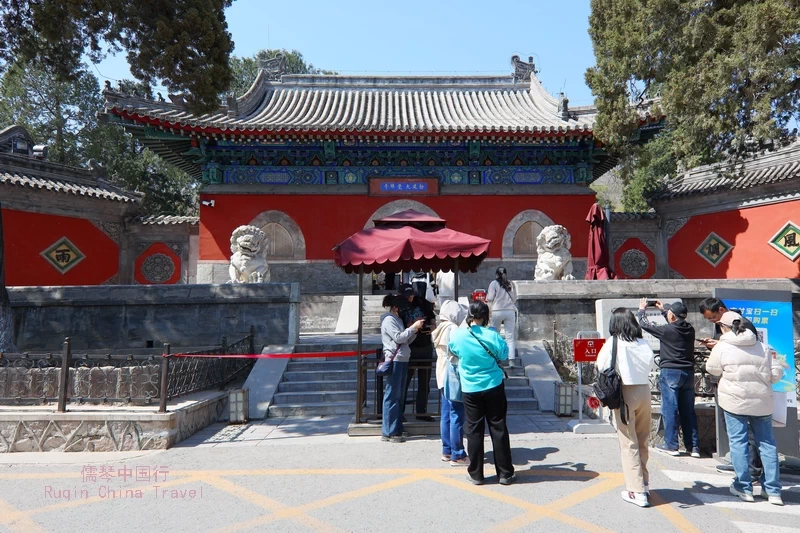
“Commissioned by Imperial Decree: Dajue Chan Temple.” (敕建大觉禅寺)
Flanking the main arched doorway are two smaller arched windows. The wooden beams above are decorated with gold-detailed swirling motifs and ink-line painting, with a central panel depicting a golden dragon. In front of the gate lies a raised moon platform, and on each side stands a rare style of curved screen wall, poetically named “A Sealed Letter.”
💧 Gongde Pool (Merit Pool) 功德池
Just behind the gate, you’ll find the Gongde Pool, also known as the Release-Life Pool — a traditional space for symbolically setting animals free as an act of compassion.
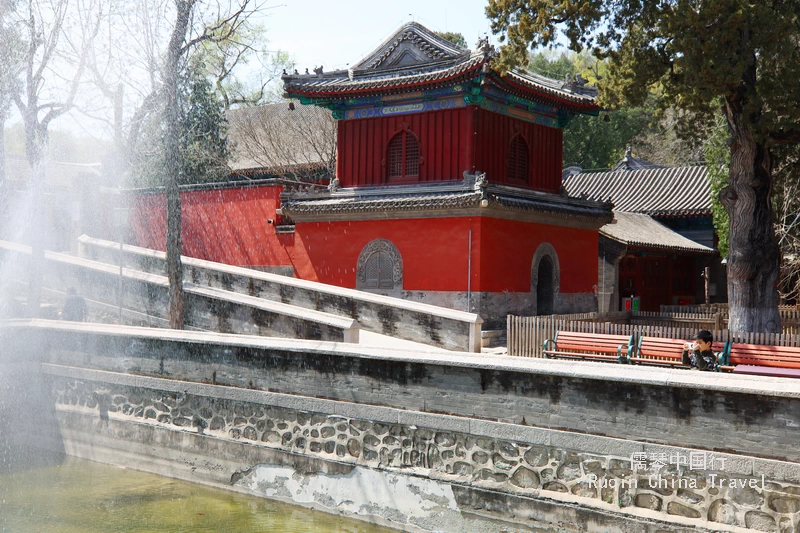
A stone bridge crosses its center, splitting the rectangular pool in two. At the north and south ends, intricately carved stone dragon heads spout water, adding to the peaceful ambiance.
🛕 Hall of Heavenly Kings (Tianwang Hall)
This is the first main hall you’ll enter. Also called the Maitreya Hall, it houses a smiling statue of Maitreya Buddha at its center, with the Four Heavenly Kings standing guard on either side. The hall maintains a Ming dynasty style — three bays wide, five beams deep, with a hipped roof and simple clay tiles.

Around the courtyard, you’ll see six auxiliary halls — three on each side — used for religious functions. Two stone pavilions sit to the east, and in the center, you’ll find the Merit Bridge arching over the Release-Life Pool. To the west stand the Bell Tower and Drum Tower, symbolizing the temple’s rhythm of daily life.
🛕Mahavira Hall (Daxiong Baodian) 大雄宝殿
At the core of Dajue Temple lies its most sacred space — the Mahavira Hall, or Daxiong Baodian. This grand hall is often referred to as the “heart” of the temple, both spiritually and architecturally. Above its entrance, a majestic plaque inscribed by Emperor Qianlong reads:

“Wu Qu Lai Chu” (No Coming, No Going) 无去来处— a reflection of Zen philosophy on the impermanence of life.
Inside, the ceiling steals the show. Look up to admire the wooden coffered ceiling, painted with lotus petals, and the exquisitely carved coiling dragon (Panlong) ceiling ornament — a rare and symbolic feature in Chinese temple architecture.

At the center of the hall, you’ll find statues of the Three Buddhas (Past, Present, and Future), known as the Three Bodies of the Buddha. The current statues were relocated from Zhihua Temple in 1972, adding layers of history and continuity to this sacred space.
🕉 Amitabha Hall (Hall of Infinite Life) 无量寿佛殿
Located in the third tier of the central route, the Amitabha Hall is a visual highlight. With five bays across, green-glazed tiles, and elegant overhanging roofs, the hall is both stately and serene. A calligraphy plaque, written by Emperor Qianlong himself, hangs above the entrance:
“Stillness and Motion in Harmony.” (动静等观)
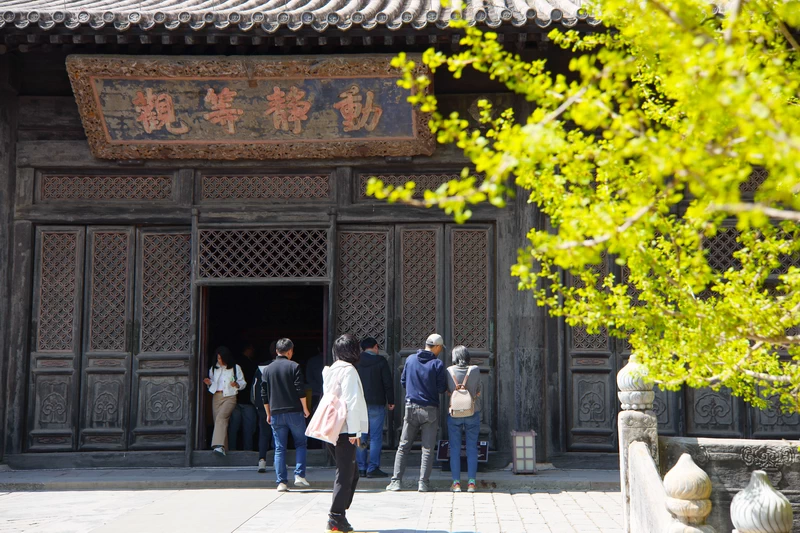
Inside, three statues stand: Amitabha Buddha flanked by two bodhisattvas. Behind them, a rare Qing dynasty clay bas-relief depicts Guanyin seated in a mystical ocean landscape.
In front of the hall, two ancient ginkgo trees stand proudly — one of them over 1,000 years old, earning it the title of “King of Ginkgo Trees.”
Stone steles from the Ming dynasty and two side halls complete the complex, with ten rooms on each side used for monastic living and rituals.
🙏 Hall of Great Compassion (Dabei Hall) 大悲堂
Also called the Hall of the Great Mercy Altar, this two-story building marks the fourth level of the temple’s central path. It features five bays, six beams deep, and a gabled roof. A beautifully crafted wooden plaque from Prince Chun (Aisin Gioro Yixuan) reads:
“The Supreme Gate of Dharma.” (最上法门)

A notable relic stands to the north: a Liao dynasty stone stele dating back to 1068, documenting the temple’s founding and the early printing of Buddhist scriptures. Behind the hall, a small stupa-like dome structure (覆钵) is nestled on the hillside.
🐉 Hall of the Dragon King (Longwang Hall) 龙王堂
The fifth tier on the temple’s central path is home to the Dragon King Hall. Compact and two stories tall, it features a gabled roof and richly painted eaves.

A square pool sits before the hall, with a dragon-head spout from which natural spring water flows, forming the mystical Dragon Pool. Several ancient cypress trees guard this quiet, atmospheric space.
⛩ Kalaviṅka Stupa (Jialing Relic Pagoda)
At the highest point of Dajue Temple’s axis stands the Kalaviṅka Stupa (迦陵舍利塔), a brilliant example of a bottle-shaped Buddhist stupa, symbolic of enlightenment and eternity.
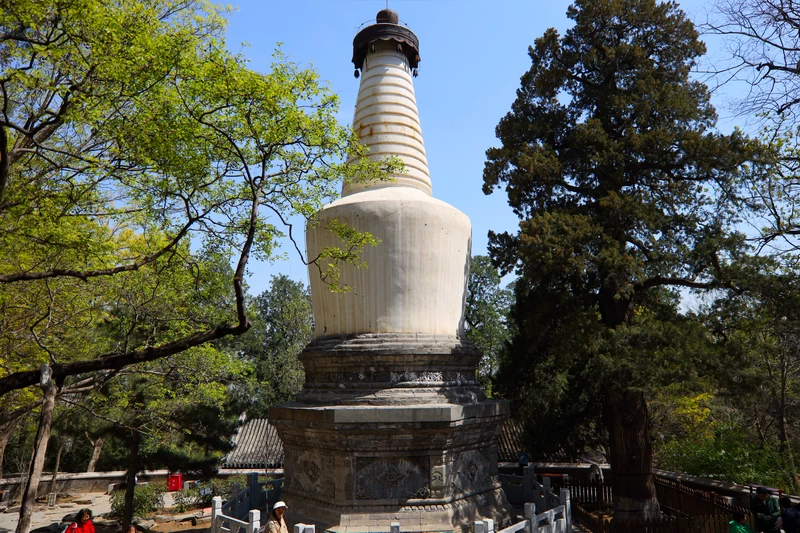
This 15-meter-high white pagoda is made of stone and brick and is divided into four parts: the crypt, base, body, and finial. The base features an octagonal platform with lotus carvings, and the stupa’s body bulges like an upturned bowl, topped by a 13-tiered parasol structure. On the very top sits a lotus crown adorned with eight wind chimes that tinkle gently in the breeze.
Ornamental brick carvings of dragons, peonies, lotuses, and exotic flowers decorate the stupa, adding a delicate richness to its spiritual presence.
3. Unique Courtyards and Scenic Highlights
Beyond its ancient halls and Buddhist architecture, Dajue Temple offers tranquil courtyards and hidden natural gems that make it a true feast for the senses — especially in spring. These spaces blend imperial elegance with Zen simplicity, inviting visitors to pause, breathe, and connect with nature.
🌸 Siyi Hall (Four Harmony Pavilion) 四宜堂
Also known as the Southern Magnolia Courtyard, Siyi Hall is one of the most charming spots in the temple’s southern wing, originally used as a Qing dynasty royal retreat. The name “Siyi” was personally chosen by Prince Yinzhen — the future Emperor Yongzheng — based on his meditation studio.
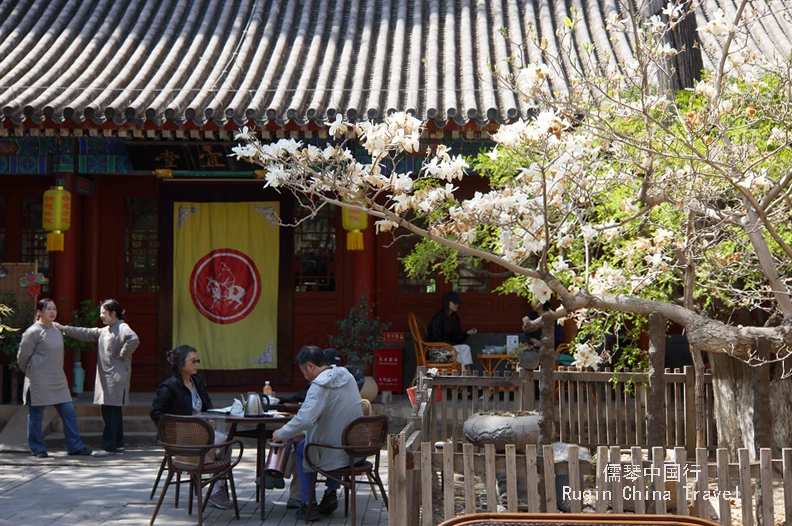
But the real star here is the ancient magnolia tree, affectionately known as the “King of Magnolias.” Over 300 years old, this towering tree comes alive each spring with a canopy of pure white, double-layered blossoms — each bloom as big as a fist. Its rich fragrance drifts through the courtyard, creating the legendary scene of “Fragrant Blossoms in the Ancient Temple.”
Legend says that the magnolia was transplanted here from Sichuan by the Chan master Jialing during the Yongzheng era. Today, it remains the centerpiece of Dajue Temple’s seasonal magic — and a must-see for springtime visitors.
🐉 Biyun Clear Pool 碧韵清池
Tucked inside the Northern Magnolia Courtyard, this elegant pool is carved entirely from a single slab of black marble. Crystal-clear spring water flows gently from a stone dragon head, creating a mirror-like surface that reflects the surrounding ancient buildings.
Above the pool, three large characters are etched in stone:
“Biyun Qing” (Clear Rhythm of Jade Green). 碧韵清池
This poetic waterscape is considered one of the “Eight Wonders of Dajue Temple.” It’s a quiet corner where time seems to slow down — perfect for a moment of reflection or a photo with classic Chinese aesthetics.
💧 Ling Spring Waters
At the highest point of the temple grounds, just in front of the Dragon King Hall, flows the legendary Ling Spring (灵泉). Fed by natural underground sources behind the mountain, its waters spill out of a dragon-head spout into a small pool, sparkling in the sunlight.
The spring runs year-round, maintaining a crisp temperature of about 8°C (46°F) — cold, clean, and refreshing. But its beauty goes beyond appearance: this spring water is used to brew the temple’s renowned Zen tea, a meditative beverage that reflects the spirit of Dajue’s peaceful lifestyle. Locals say the sweet, pure taste of the tea comes from the spring itself.
4. Ancient Trees and Botanical Wonders
Beijing Dajue Temple isn’t just rich in architecture and history — it’s also home to some of Beijing’s most fascinating old trees. Beyond the famed magnolia, you’ll find rare and resilient species that have stood here for centuries, quietly witnessing the temple’s long legacy.
🌳 The Thousand-Year Ginkgo King
In front of the Amitabha Hall, two towering ginkgo trees catch the eye. The northern tree is especially impressive. Locals call it the “Thousand-Year Ginkgo” or the “Liao Dynasty Ginkgo King.” According to tradition, monks planted it during the Liao dynasty — making it more than 900 years old.
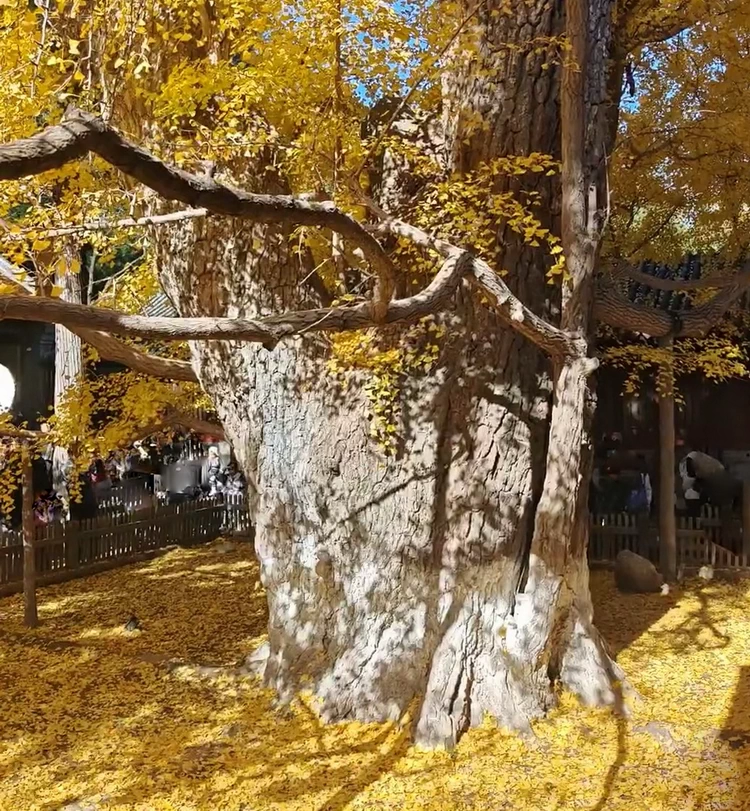
The tree stands about 25 meters tall, with a trunk diameter of 7.5 meters. Its thick canopy casts deep shade in the warmer months, and its golden leaves glow in autumn. Even Emperor Qianlong praised the tree in a poem:
“This ancient trunk spans many men in girth.
Its thick leaves and branches stretch wide with time.
It has seen centuries pass like a dream,
A living memory of the mountain’s founding.”
The poem captures the awe many feel standing beneath this living monument.
🌿 Rare Plant Coexistence: Vines and Trees as One
Nature has worked a bit of quiet magic in Dajue Temple. In two special places, you can see unique examples of plant symbiosis, where different species grow together as one.
First, near the Gongde Pool Bridge, an old cypress supports a twisting vine that grows straight out of its lower trunk. This rare pairing is known as “The Vine on the Cypress.”
Second, in the Siyi Hall Courtyard, look for the large cypress west of the magnolia. About a meter above the ground, the trunk splits into two — and right in the fork grows a buckthorn tree. This natural oddity is called “Buckthorn on Cypress.”
5. Seasonal Scenery and the Best Time to Visit
Dajue Temple offers something special in every season. Whether you’re chasing spring blossoms or craving a snowy retreat, each visit feels unique. Understanding how the temple transforms throughout the year will help you choose the perfect time for your trip — and make your experience even more memorable.
🌸 Spring (Late March to Early April): Magnolia Season in Full Bloom
Spring is when Dajue Temple truly shines. From late March to early April, the famous 300-year-old magnolia tree bursts into bloom. Its pure white, fragrant flowers cover the branches, creating the signature seasonal scene known as “Fragrant Blossoms in the Ancient Temple.”

Because the temple sits in the Western Hills, its temperature is slightly cooler than downtown Beijing. As a result, the magnolias here usually bloom about 10 days later than those in the city, peaking in early April. The flowers last for around a week, but on sunny, mild days, the bloom can stretch even longer.
If you’re planning a spring trip to Beijing, timing your visit around this bloom offers an unforgettable highlight.
🌿 Summer (May to September): A Cool Escape from the City
Looking for a break from Beijing’s summer heat? Dajue Temple becomes a refreshing retreat from May through September. Towering ancient trees cast deep shade, and cool mountain breezes make the air feel crisp and clean.
Temperatures here are usually 3–5°C lower than in the city center, which makes it a popular spot for those seeking peace and coolness. The Biyun Clear Pool and flowing Ling Spring offer extra freshness, while cicadas sing in the background — creating a calm, meditative atmosphere that feels far from the urban rush.
🍂 Autumn (October to November): A Golden Sea of Ginkgo Leaves
Autumn brings another burst of beauty. From October to November, Dajue Temple’s ancient ginkgo trees turn a glowing shade of gold. The contrast between the golden leaves, gray rooftops, and red temple walls is stunning — like a living painting.
In front of the Amitabha Hall, the legendary 900-year-old “Ginkgo King” sheds its leaves in waves. They blanket the stone paths in a golden carpet, making this season a favorite for photographers and nature lovers alike.
❄️ Winter (December to February): Snow-Covered Serenity
Winter is the temple’s most underrated season. From December through February, visitor numbers drop, but the beauty remains. After a snowfall, the temple turns into a peaceful wonderland — red walls, gray tiles, and white snow combine to create a scene straight out of a Chinese ink painting.
This is the perfect time to experience true Zen tranquility. With fewer crowds and the sound of snow gently falling, you’ll feel the deep calm known as “silence in the winter temple.” It’s ideal for introspection, photography, or simply a quiet walk through history.
6. Tea and Vegetarian Dining: Savoring Zen at Dajue Temple
A visit to Beijing Dajue Temple isn’t just a cultural or spiritual journey — it’s also a chance to explore the flavors of Zen. From tranquil tea ceremonies to refined vegetarian cuisine, the temple invites visitors to slow down and enjoy mindful moments with every sip and bite.
🍵 Zen in a Cup: The Minghui Tea House Experience 明慧茶院
Tucked within the temple grounds, the Minghui Tea House offers a serene setting to experience “Zen and tea as one.” It’s more than just a place to drink — it’s a window into Chan (Zen) philosophy.

What makes the tea here so special? The answer lies in the water. The tea is brewed using the temple’s legendary Ling Spring, which flows year-round at a refreshing 8°C (46°F). The result is a cup of tea that tastes clean, pure, and gently sweet.
During your visit, you’ll witness tea ceremonies infused with Zen teachings. Every gesture — from pouring to serving — reflects mindfulness. The peaceful setting, paired with the scent of warm tea, helps you relax deeply, both physically and spiritually.
The experience does come at a premium. Tea snacks typically cost 20–30 RMB per portion, though servings are small. Loose-leaf teas start around 200–300 RMB per packet, and there’s an additional 20 RMB charge for hot spring water. However, what you’re really paying for is the entire atmosphere — from ancient trees and soft Guqin music to traditional attire and dim palace lanterns. Occasionally, you may even hear a resident monk sharing reflections on Zen, turning tea time into a moment of true spiritual enrichment.
🥦 Vegetarian Cuisine: Zen on the Tip of the Tongue
The temple’s Lingzhi Vegetarian Restaurant enjoys a strong reputation — not only among Buddhists but also among food lovers who venture into the Western Hills for a taste of something unique.
Located in the former abbot’s residence, the restaurant offers a peaceful, garden-like atmosphere. The menu is entirely plant-based, but each dish is crafted with artistry and imagination like:
Vegan abalone
“One-Finger Zen” vegan sausage
Plant-based sashimi
Imitation chicken wings
Vegetarian twice-cooked pork
For visitors craving the flavors of southern China, Dajue Temple also houses a Shaoxing-style restaurant, transformed from the temple’s old disciplinary hall.
7. Practical Information for Visiting Dajue Temple
Planning your visit to Beijing Dajue Temple? Here’s everything you need to know — from how to get there, to ticket details and opening hours — so you can make the most of your trip.
📍 Location
- Address: No. 9 Dajuesi Road, Sujiatuo Town, Haidian District, Beijing 北京市海淀区苏家坨镇大觉寺路9号
- Distance from downtown Beijing: Approx. 30 km (about 1 hour by car or transit)
🚇 How to Get There
There are several convenient ways to reach Dajue Temple:
By Subway:
- Take Beijing Metro Line 4 to Sujiatuo Station.
- From there, it’s about a 15-minute walk to the temple.
- Alternatively, transfer to Bus 633 and get off at Dajuesi Station — just a 5-minute walk from the entrance.
By Car (Self-Drive):
- Use GPS or map apps to navigate to:
No. 9 Dajuesi Road, Sujiatuo Town, Haidian District - Ample parking is available just outside the temple, making this a great option for families or small groups.
🎟 Tickets and Opening Hours
- Opening Hours: Daily, 9:00 AM – 5:00 PM
(Last entry and ticket sales close at 4:30 PM) - Admission: ¥20 per person
How to Buy Tickets:
- On-site:
Purchase tickets at the ticket window near the entrance. - Online:
Follow the official WeChat public account.
Reply with “大觉寺” (Dajuesi) to receive a link for e-ticket purchase.
✅ No paper ticket needed — simply scan your phone to enter.
8. Nearby Attractions: Perfect Pairings for a Day Trip
Located in Beijing’s scenic western suburbs, Beijing Dajue Temple sits within a cultural and ecological corridor rich in historical and natural beauty. If you have time, it’s well worth combining your temple visit with other nearby sites for a full day of discovery.
Here are some top attractions near Dajue Temple — all ideal for a one-day itinerary:
🍁 Fragrant Hills Park (Xiangshan Park)
- Distance: Approx. 8 km
- Highlights: One of Beijing’s most famous spots for autumn foliage. Come in October or November to see the hills blanketed in fiery red maple leaves.
- Why Go: It’s the perfect follow-up to Dajue Temple’s golden ginkgo trees.
🛕 Wofo Temple (Temple of the Reclining Buddha)
- Distance: Around 6 km
- Highlights: A peaceful temple known for its massive bronze reclining Buddha statue.
- Why Go: Offers a more intimate, spiritual experience with fewer crowds.
🌸 Beijing Botanical Garden
- Distance: About 10 km
- Highlights: Bursting with seasonal blooms, especially vibrant during spring flower festivals.
- Why Go: A great afternoon stop after admiring magnolias at Dajue Temple in early April.
🏯 Summer Palace (Yiheyuan)
- Distance: Around 15 km
- Highlights: Summer Palace, a UNESCO World Heritage Site and one of China’s finest imperial gardens.
- Why Go: Enjoy the serenity of Kunming Lake, marble boats, and palace pavilions.
🏚 Old Summer Palace (Yuanmingyuan Ruins Park)
- Distance: Approx. 18 km
- Highlights: Explore a hauntingly beautiful mix of historic ruins and garden landscapes.
- Why Go: Dive into Qing dynasty history while wandering among the remnants of grand palaces and waterways.
Dajue Temple is more than just an ancient Buddhist site — it’s a quiet haven where history, nature, and spirituality come together. Whether you’re visiting for the magnolia blossoms in spring, escaping the heat in summer’s cool shade, admiring the golden ginkgo leaves in autumn, or soaking in the snow-covered silence of winter, this temple offers a unique experience in every season.
From elegant halls and rare ancient trees to soothing tea ceremonies and mindful vegetarian meals, every corner of Dajue Temple invites reflection and calm. It’s a perfect escape from the buzz of Beijing — one where you can slow down, breathe deeply, and reconnect with something timeless.
If you’re looking for a cultural experience that goes beyond the typical tourist path, Beijing Dajue Temple is a hidden gem waiting to be explored.


